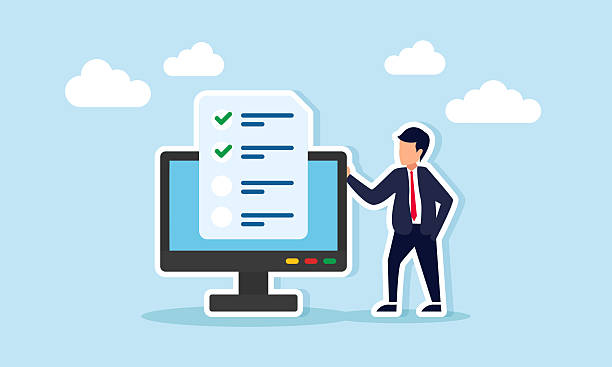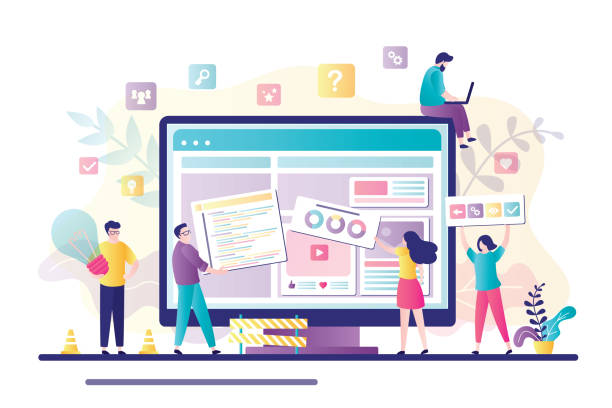Introduction to the Importance of Multilingual Website Design

In today’s world, where geographical boundaries have faded due to the internet, #GlobalAccess and #InternationalAudienceEngagement have gained increasing importance.
One of the most effective ways to achieve this goal is multilingual website design.
This approach allows businesses and individuals to deliver their message to audiences in various languages, significantly expanding their user base.
Beyond mere text translation, multilingual website design is a comprehensive strategy that requires a deep understanding of different cultures, international SEO, and related technical challenges.
This article, serving as an educational and explanatory resource, will guide you step-by-step through the complex yet fruitful path of multilingual website design.
The first step on this path is to understand why having a website accessible in multiple languages is no longer a competitive advantage, but a necessity.
This is especially vital for companies looking to enter new markets or offering products with global potential.
Imagine your website is only in one language; this means losing a huge portion of the world’s online population.
With a multilingual website design, you will be able to respond to the language needs of users from any part of the world and provide a better user experience for them.
This not only helps increase website traffic but also boosts conversion rates and, ultimately, business growth.
In this regard, the discussion of content that raises questions also arises, as mere translation is not enough; the content must be localized in a way that aligns with the culture and expectations of the target audience and answers their questions.
A good multilingual website can build user trust, as it demonstrates your respect for their language and culture.
This investment will ultimately lead to a significant return on investment.
In the following sections of this article, we will delve expertly and in more detail into each aspect of multilingual website design, from platform selection to SEO and maintenance issues.
Are you bothered by losing customers who visited your site to make a purchase?
RasaWeb is your specialized solution for a successful online store.
✅ Significant increase in your online sales
✅ Building trust and professional branding with customers⚡ Get free consultation from RasaWeb experts!
Benefits of Implementing Multilingual Websites

Implementing a multilingual website brings numerous benefits for businesses and online projects.
One of the most prominent benefits is #MarketExpansion and #ReachingNewAudiences.
By providing content in various languages, you can easily penetrate international markets and attract customers who were previously unable to interact with your website due to language barriers.
This is particularly crucial for e-commerce companies, service providers, and news websites.
Increased website traffic is another key benefit.
Search engines like Google display multilingual content locally in search results, which leads to improved SEO rankings and attracts more visitors.
As an analytical section, it can be said that every language you add to your website effectively opens a new door to a new market.
This traffic increase is beneficial not only quantitatively but also qualitatively, as users find content in their native language, which means deeper engagement and higher conversion rates.
Improved user experience is also an undeniable advantage.
When users can read the information they need in their own language, they feel more comfortable and trusting of your website.
This approach guides on how to increase customer loyalty and encourage repeat visits by providing a seamless user experience.
This sense of closeness and cultural connection plays an important role in the decision to purchase or use your services.
In terms of #Branding, multilingual website design helps create a professional and global image for your brand.
This demonstrates that you care about the needs of your customers worldwide and are ready to provide your services in the best possible way.
Furthermore, this strategy can differentiate you from competitors, especially if your competitors have not yet realized the importance of multilingual website design.
Finally, by using multilingual website design, you can obtain valuable data on user behavior in different regions and optimize your marketing strategies based on this information.
This means more informed decisions and greater long-term success.
Therefore, investing in multilingual website design is a strategic and smart decision whose benefits will far outweigh its initial costs.
Choosing Translation and Content Management Strategies

One of the most important steps in the multilingual website design process is choosing the right strategy for translation and content management.
This decision affects not only the quality of the translated content but also the cost, time, and ease of future website maintenance.
As a specialized section, you should know that there are three main approaches to content translation: machine translation, human translation, and a combination of both.
#MachineTranslation, like Google Translate, is fast and inexpensive but does not offer sufficient accuracy and localization and is generally not recommended for important content.
#HumanTranslation is performed by professional translators who ensure high accuracy, cultural localization, and appropriate tone, but it is more time-consuming and expensive.
The combined approach uses machine translation as a draft and then edited by a human, which can create a balance between cost and quality.
For a successful multilingual website design, this strategy must be chosen carefully.
Alongside choosing the translation method, content management is also of particular importance.
Content Management Systems (CMS) like WordPress with plugins such as WPML or Polylang, or Drupal and Joomla, provide easy management of different language versions of content.
These plugins help you organize content, link translated versions, and easily apply changes.
A strong content management strategy ensures that every page of your website is displayed correctly in different languages and no content is missed.
This section provides guidance on how to simplify the complex translation process.
Table 1: Comparison of Content Translation Strategies
| Feature | Machine Translation | Human Translation | Combined (Machine + Human) |
|---|---|---|---|
| Accuracy & Quality | Low to Medium | High | Medium to High |
| Speed | Very High | Low | Medium |
| Cost | Low | High | Medium |
| Cultural Localization | No | Yes | Partial |
| Suitable for | Non-sensitive, basic content | Core, marketing, legal content | Large websites with moderate budget |
Also, you should consider organizing your URL structure, such as using subdomains (fa.example.com), subfolders (example.com/fa/), or URL parameters (example.com?lang=fa).
Each has its own advantages and disadvantages in terms of SEO and user experience.
Ultimately, your approach to multilingual website design must align with your business goals and budget to achieve the best results.
This detailed analytical and specialized analysis is crucial for the success of multilingual website design projects.
Technical Challenges in Multilingual Website Design

The multilingual website design project, despite its numerous benefits, also comes with specific technical challenges that need to be carefully addressed.
One of the first challenges is the website’s #TechnicalInfrastructure.
Does your current CMS (Content Management System) support multilingual functionality, or does it require fundamental changes? This can be a specialized issue requiring deep technical knowledge.
Choosing the appropriate URL structure (such as subdomains, subfolders, or parameters) is crucial from a technical and SEO perspective and affects how pages are indexed by search engines.
For example, Google recommends using subfolders for multilingual sites because they are easier to manage.
Another challenge is #SupportForDifferentCharacters and #TextDirection.
Languages like Persian and Arabic are written from right to left (RTL), while most languages are left to right (LTR).
This difference requires changes in CSS and user interface (UI) design to provide an optimal visual experience.
The coding must be such that it can handle these differences correctly.
Managing images and multimedia files can also be challenging.
Do your images need translation or localization? How do you manage these images for each language so that the site size doesn’t increase and loading speed doesn’t decrease? This is a guidance point you should consider from the outset.
Furthermore, website performance optimization is of great importance.
With the addition of more languages, the volume of content and server requests increases.
Ensuring that your website remains fast and efficient requires database optimization, the use of CDN (Content Delivery Network), and proper caching.
These technical issues add an analytical aspect to the multilingual website design project, which must be managed by experienced developers.
Potential errors and problems can disrupt the user experience and even harm SEO rankings.
For instance, issues with hreflang tags or incorrect redirects can confuse search engines.
Ultimately, multilingual website design is a complex project that requires precise technical planning and sufficient resource allocation to address these challenges.
Ignoring these issues can lead to serious problems in the future and jeopardize your website’s success.
Does your current e-commerce website design not generate the expected sales for you?
RasaWeb specializes in professional e-commerce website design!
✅ An attractive and user-friendly website aimed at increasing sales
✅ High speed and security for an ideal shopping experience⚡ Get a free consultation on online store design with RasaWeb!
SEO Optimization for Multilingual Websites (SEO Multilingual)

One of the most important aspects of successful multilingual website design is optimizing it for search engines on an international scale, which is known as #MultilingualSEO or #InternationalSEO.
This process goes beyond mere keyword translation and requires a deep understanding of how search engines handle multilingual content.
The first explanatory and educational step in this area is the correct use of the `hreflang` tag.
This tag informs search engines like Google and Yandex which version of the page is suitable for which language and geographical region.
Incorrect use of it can lead to duplicate content issues.
For example, if a page is available in both Persian and English, `hreflang` tells the search engine which audience each version is for.
URL structure selection is also vital in multilingual SEO.
As mentioned earlier, subdomains (e.g., en.example.com), subfolders (e.g., example.com/en/), and parameters (e.g., example.com?lang=en) each have a different impact on SEO.
Many SEO specialists prefer subfolders due to their ease of management and domain authority consolidation.
Analyzing competitors in target markets and finding appropriate keywords for each language is also essential.
A keyword effective in one language may have a different meaning or less search volume in another.
This section requires an analytical and localized approach.
Translated content must be of high quality and localized for local audiences.
Mere word-for-word translation is not enough; the content must be culturally and linguistically engaging and answer user questions.
This can include changes in examples, cultural references, and even sentence structure.
Building local backlinks and increasing domain authority in each region also helps SEO ranking.
This process is time-consuming but brings sustainable results.
Tools like Google Search Console help you monitor your multilingual site’s performance and identify potential issues.
Ultimately, multilingual website design with strong SEO means ensuring your visibility in international search results.
Ignoring these aspects can nullify your investment in multilingual website design.
User Experience and User Interface Design in Multilingual Websites

When #DesigningAMultilingualWebsite, beyond content translation, special attention must be paid to user experience (UX) and user interface (UI) design.
An #OptimalUserExperience ensures that your visitors, regardless of language, can easily navigate the website and access the information they need.
The first point in this regard is to place the language change option in an accessible and clear location.
This is usually visible in the header, footer, or a dropdown menu.
Country flag icons can be helpful, but it’s better to also write the language name in text to avoid ambiguity.
This is a key guideline for ease of use.
Responsive Design also gains double importance for multilingual sites, as translated content may have different lengths and affect page layout.
It must be ensured that the design does not break across different devices and with texts of varying lengths.
This is particularly vital for languages like German, which have long words, or Asian languages, which have different character structures.
Colors, images, and symbols should also be culturally reviewed.
What has a positive meaning in one culture may be negative or meaningless in another.
Visual localization is as important as content localization.
This is a topic that raises questions about how to maintain a unified visual identity across different cultures.
Page loading speed is also an important factor in user experience.
International users may access your website from regions with slower internet speeds or more distant servers.
Optimizing images, using CDN, and compressing code are essential to ensure fast page loading in every language.
Error messages, forms, and Call to Action buttons must also be properly translated and localized.
A small translation error can confuse the user and lead to lost conversions.
Ultimately, a multilingual website design with an engaging and attractive approach to user experience not only improves website performance but also enhances user credibility and trust.
This shows that you care about the details and needs of your global audience.
Considering these points, multilingual website design can be very successful.
Suitable Tools and Platforms for Multilingual Design

Choosing the right #Tools and #Platform for multilingual website design can make a big difference in the ease of implementation, cost, and maintenance of the project.
Currently, there are numerous options available for this purpose, each with its own unique features and capabilities.
For Content Management Systems (CMS), WordPress is one of the most popular choices.
By using plugins like WPML (WordPress Multilingual Plugin) or Polylang, you can easily make your website multilingual.
WPML is a comprehensive and specialized plugin that allows for the translation of posts, pages, categories, tags, and even theme and plugin strings.
Polylang is also a lighter and free option for less complex needs.
Table 2: Common Tools for Implementing Multilingualism in CMSs
| CMS | Main Plugin/Module | Key Features | Suitable For |
|---|---|---|---|
| WordPress | WPML, Polylang | Full content translation, international SEO, high compatibility | Small to large sites, blogs, e-commerce stores |
| Drupal | Core Multilingual Modules, Entity Translation | High power, flexibility, suitable for complex projects | Enterprise portals, government websites, large projects |
| Joomla | Core Multilingual Features, Falang | Ease of use, active user community | Medium sites, personal sites |
For e-commerce platforms, Shopify and Magento also offer multilingual capabilities, although some features may require third-party plugins.
Some of these platforms even provide internal translation services or integration with translation service providers.
In addition to CMSs, automatic translation services and Translation Management Platforms (TMS) such as Smartling, Phrase, and Crowdin can also assist with the translation and localization process.
These tools enable the management of large translation projects, collaboration with translators, and the maintenance of terminology consistency.
The choice of platform and tools should be based on the specific needs of your project, budget, and your team’s technical knowledge.
An informed decision at this stage can significantly streamline the multilingual website design process.
This explanatory and guiding section helps you make the best choice for your multilingual website design.
Security and Maintenance Tips for Multilingual Websites

Security and maintenance are two crucial aspects often overlooked in the initial stages of multilingual website design, yet they play a significant role in the long-term success and stability of the website.
With the addition of more language layers and content, the complexity of the website increases, which can create new vulnerabilities for security attacks.
#MultilingualWebsiteSecurity requires special attention to regular updates of software, plugins, and themes across all language versions.
Any vulnerability in a multilingual plugin or the CMS itself can harm the entire website.
The use of Web Application Firewalls (WAF) and SSL certificates for data encryption in all languages is essential.
This is the most specialized need for maintaining user data security.
Protection against SQL injection, XSS, and CSRF attacks must be implemented in all forms and user inputs, regardless of language.
Continuous analysis of server logs to identify suspicious activities is also of high importance.
In terms of #MultilingualWebsiteMaintenance, regular processes for backing up the database and files across all language versions should be established.
Any issue in one language can affect the performance of other languages as well.
Ensuring that all links (internal and external) function correctly in all languages and that there are no broken links or incorrect redirects is crucial.
This section includes an explanation of the importance of continuous quality control.
Furthermore, monitoring website performance, including page loading speed in different geographical regions, is very important for each language.
CDNs (Content Delivery Networks) can be helpful in this regard.
Database management and optimization for high content volume and various languages are also among the maintenance tasks.
It must be ensured that the database is optimized and queries are responded to quickly.
Guidance for multilingual website maintenance also includes periodic reviews of translation and localization quality.
Language is a living entity, and terms or trends may change; therefore, reviewing and updating content is essential to maintain relevance with local audiences.
Ultimately, multilingual website design is not just about launching it, but requires a comprehensive strategy for long-term security and maintenance to protect your investment and provide an optimal user experience in all languages.
This proactive approach will guarantee the sustainable success of your international website.
Tired of losing customers due to poor e-commerce website design? With RasaWeb, solve this problem forever!
✅ Increase sales and visitor-to-customer conversion rates
✅ Smooth and engaging user experience for your customers⚡ Get a free consultation
Case Studies and Successes of Multilingual Website Design

To better understand the potential and benefits of multilingual website design, examining #SuccessStories and #CaseStudies can be highly educational.
Many large and small companies have achieved significant success in global markets by implementing multilingual strategies.
One of the most prominent examples is global e-commerce companies like Amazon and eBay, which have generated billions of dollars in revenue from international markets by offering their services and products in multiple languages.
Their success is not limited to simple translation but includes full localization of the shopping experience, including currencies, payment methods, and customer support in the local language.
These examples show how powerful multilingual website design can be.
Another example is software companies like Microsoft or Google, which offer their products and services in dozens of languages.
This approach allows them to reach millions of users worldwide and hold a significant share in the global competitive market.
This demonstrates a specialized and deep analytical approach to market needs.
Even small and medium-sized businesses can benefit from multilingual website design.
For example, a boutique hotel in Italy that offers its website in English, German, French, and Spanish can attract more tourists from different countries and increase its bookings.
This is practical guidance on how even local businesses can go global.
A news example could be about a tech startup that tripled its international user base within a year by launching its website in multiple languages.
These success cases show that investing in multilingual website design is not just an expense, but a high-return investment.
These case studies can also provide valuable lessons about the challenges and solutions related to multilingual website design.
Among these lessons are the importance of carefully selecting languages based on market research, deep content and user experience localization, and investing in international SEO.
These examples prove that with proper planning and correct execution, any business can benefit from a multilingual website and become a global player.
The Future of Multilingual Website Design and New Trends

The future of #MultilingualWebsiteDesign is rapidly evolving, with new trends emerging that make this field increasingly attractive and efficient.
One of the most important upcoming trends is #ArtificialIntelligence and #MachineLearning in translation.
With recent advancements in Large Language Models (LLMs) and Neural Machine Translation, the accuracy and fluency of machine translations have significantly improved.
In the future, we will see deeper integration of these technologies into multilingual website design platforms, enabling instant translation and content localization with very high quality.
These advancements can be very interesting as news for web developers.
Another trend is the increasing importance of localization beyond just language.
This includes adapting content to the cultural, social, economic, and even legal characteristics of each region.
Users expect not only the website’s language to be in their native tongue but also for content, products, and services to be tailored to their local needs and expectations.
This aspect requires a more analytical and in-depth approach to international marketing strategies and goes beyond a simple explanation.
Furthermore, specialized tools for Translation Workflow Management are expected to become more advanced.
These tools help businesses efficiently manage the translation process from start to finish, including ordering translations from linguists, quality assurance, and publishing content in various languages.
This could also include integration with marketing and CRM tools.
The development of Progressive Web Apps (PWAs) and Voice-enabled Websites are also significant trends that will impact multilingual website design.
Ensuring that multilingual content is optimized for voice search and provides a seamless experience across different platforms will become increasingly important.
Finally, with the increasing growth of emerging markets and expanded internet access in various parts of the world, the need for multilingual website design will be felt more than ever.
Companies and organizations that are aware of these trends and make the necessary investments will lead the competition in the global digital world.
This intriguing view of the future shows that multilingual website design will never lose its importance and will always continue to advance.
Frequently Asked Questions (FAQs)
| Question | Answer |
|---|---|
| What is a multilingual website? | It is a website whose content is available to users in several different languages. |
| Why should we design a multilingual website? | To expand reach to international audiences, increase website traffic, improve SEO in target markets, and provide a better user experience for non-Persian-speaking users. |
| What are the main methods for implementing a multilingual website? | Using subdomains (e.g., en.mysite.com), using subdirectories (e.g., mysite.com/en/), and using separate domains for each language (e.g., mysite.com and mysite.de). |
| Which implementation method is better for SEO? | Generally, using subdirectories (language folders) is often recommended due to the transfer of the main domain’s authority to other languages. |
| What is the Hreflang tag and what is its use? | It is an HTML tag or HTTP Header that tells search engines which version of a page is suitable for which language or geographical region. This tag prevents duplicate content and improves SEO. |
| How is a Language Switcher designed? | Usually by using a dropdown menu, button, or flag in the website’s header or footer, which allows the user to select their preferred language. |
| Is automatic (machine) translation suitable for a multilingual website? | No, machine translation usually has low quality and many errors that can harm the site’s credibility. Human translation or a combination of human translation and machine editing is recommended. |
| What are the most important SEO tips for multilingual website design? | Correct use of the Hreflang tag, having an appropriate URL structure for each language, translating meta titles and descriptions, translating core content, and internal linking between related language versions. |
| Should all website content be translated? | It depends on the strategy. Typically, the main and important content of the site should be translated. Less important sections or blogs may not require full translation. |
| What are the main challenges in multilingual website design? | Managing content in different languages, translation costs, technical issues related to URLs and language tags, theme compatibility with right-to-left (RTL) languages like Persian and Arabic, and managing multilingual SEO. |
And other services of RasaWeb advertising agency in the field of advertising
Smart Brand Identity: A professional solution for analyzing customer behavior with a focus on precise audience targeting.
Smart Digital Advertising: Designed for businesses seeking to increase website traffic through user experience customization.
Smart Marketing Automation: Revolutionize customer acquisition by optimizing key pages.
Smart Direct Marketing: Designed for businesses seeking digital branding through optimizing key pages.
Smart Digital Branding: A dedicated service for growth in customer acquisition based on the use of real data.
And more than hundreds of other services in the field of internet advertising, advertising consulting, and organizational solutions
Internet Advertising | Advertising Strategy | Advertorial
Sources
Advantages of Multilingual Website DesignSEO for Multilingual WebsitesHow to Implement a Multilingual WebsiteMultilingual Website Development
? To elevate your business in the digital world and achieve unprecedented success, RasaWeb Afarin Digital Marketing Agency stands by you with its expertise and experience. From user-friendly website design and SEO optimization to executing targeted advertising campaigns, we are ready to transform your brand in the online space and pave the way for sustainable growth.
For consultation and services, contact us.
📍 Tehran, Mirdamad Street, next to Bank Markazi, Southern Kazeroon Alley, Ramin Alley No. 6



